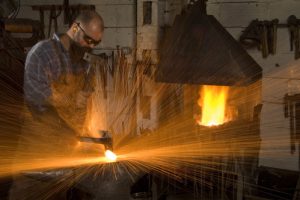Forge Welding
In this welding process, the work-pieces to be welded are heated to the plastic condition (above 1000°C), and then placed together and forged while hot by applying force. Force may be applied by hammering, rolling, drawing or squeezing to achieve the forging action. Forge welding was originally the first process of welding. In this process the two metal pieces to be joined are heated in a forge or furnace to a plait condition and then they are united by pressure. The ends to be joined are heated in a furnace to plastic condition and formed to the required shape by upsetting. Then they are brought together and hammered, so as to get the finished joint similarly, a butt joint can be prepared by forge welding as shown in Fig. Before joining the two pieces, their ends are formed to the required shape according to the type of joint. The forge welding is a manual process and is limited to light work because all forming and welding are done with a hand sledge. It is a slow process and there is considerable danger of an oxide scale forming on tile surfaces. The tendency to oxidize can be counteracted somewhat by using a thick fuel bed and by covering the surfaces with a fluxing material, which dissolves the oxides. Borax in combination with salt ammoniac is commonly used as flux. The forge welding is recommended to such metals, which have a large welding temperature range like low carbon steel and wrought iron. By the increase of carbon content, this range decreases rapidly. High carbon steels alloy steels require considerably more care in controlling temperature and producing the welds. Large work may be welded in hammer forges driven by steam. Welded steel pipe is made mechanically by running the preheated strips through rolls, which form the pipe to size and apply the necessary pressure for the weld. Source A Textbook of Basic Manufacturing Processes and Workshop Technology by Rajender Singh.
